The Irish Civil War – A short military history
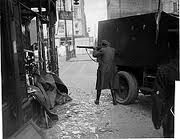
By John Dorney
(See also the Irish Civil War a Brief overview)
The Irish Civil War, the conflict between rival nationalist factions over whether to accept the Anglo Irish Treaty, brewed for six months after the Dail voted for its acceptance on January 7 1922.
They were six months of jockeying for position, skirmishes and political manoeuvring, before open warfare burst out when the Provisional Government, led by Michael Collins, opened fire on the anti-treaty garrison at the Four Courts in central Dublin on June 28 1922.
Many observers have pondered why the subsequent conflict dragged out for so long. Many participants, including for instance, Free State Ministers Ernest Blythe and Kevin O’Higgins would derisively say that it was ‘barely a war at all’ and even anti-Treatyites such as Ernie O’Malley would argue that their guerrilla campaign was futile and ineffective.
In fact though, the anti-Treaty guerrilla campaign as envisaged by Liam Lynch, which was aimed as much at the Free State’s institutions of law and tax collection and its transport and economic infrastructure as at its military, did come close to bringing down the Free State through bankruptcy.
And for all of the IRA’s relative military ineffectiveness, there were two distinct periods of crisis for the Free State; one in the early autumn of 1922 when its military appeared to be pinned in garrisons by guerrilla warfare and then again around the turn of the year 1922-23, when pending bankruptcy and economic sabotage threatened to undermine the state.
This helps to explain why the conflict dragged out for nine painful months and why the pro-Treaty side resorted to relatively drastic use of executions and wholesale internment to bring it to an end.
Taking the cities and towns
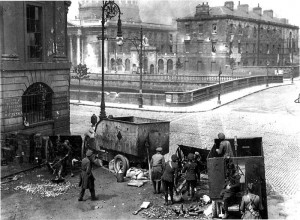
Initially the Provisional Government hoped that fighting would be limited to the operation to take the Four Courts and then to clearing the ‘Irregulars’ from Dublin city.
This operation was over within a week, the Four Courts garrison surrendering after three days’ bombardment and the storming of one side of the complex. Meanwhile the disjointed efforts of the anti-Treaty IRA Dublin Brigade to relieve them were defeated and then an attempted counter-attack that massed at Blessington was dispersed.
The fighting resulted in at least 80 people killed and perhaps 300 wounded, as well as the Four Courts itself and much Dublin’s main street – O’Connell Street – being destroyed, but it left the Provisional government in firm control of the Irish capital.
Liam Lynch, the IRA Chief of Staff was detained during the Dublin fighting but released, in the mistaken view that he was a moderate and would limit conflict around the country. This hope was quashed when anti-Treaty units around the country, under Lynch’s leadership, reacted to the attack on their comrades in the Four Courts by expelling pro-Treaty garrisons from their territory.
It was clear, therefore by the second week of July 1922, that the Civil War could not be confined to Dublin, but Collins and his lieutenants still hoped to wrap it up in short order. Gearoid O’Sullivan, the Army Adjutant General told Cabinet that, ‘the Irregulars all over the country could be disposed of in a week or a fortnight’. [1]
Initially this appeared to be true. Drogheda, which fell into anti-Treaty republican hands during the fighting in Dublin, was retaken within a week. Forces from the main National Army Headquarters outside Dublin, Athlone, under Sean MacEoin, occupied Galway city with minimal loss of life and landed by sea in County Mayo, ousting the anti-Treatyites from the main towns there. An expedition to Donegal similarly dispersed anti-Treaty columns there, in part composed of men from Cork and Kerry, who had been sent there in early 1922 purportedly for an offensive on Northern Ireland.
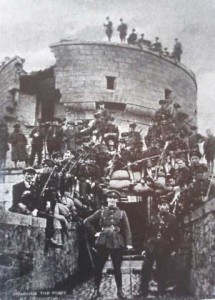
A shaky truce in Limerick city between rival pro-and anti-Treaty garrisons lasted until July 11th when firing broke out in the city. On the 17th , after Eoin O’Duffy had arrived from Dublin with reinforcements including armoured cars and artillery, the anti-Treaty IRA abandoned Limerick and retreated south, though they, Cork and Kerry as well as Limerick Brigades, put up some heavy resistance in the countryside around Killmallock and Newcastlewest, for a time stalling the pro-Treaty forces’ advance.
In the east, Waterford city was taken by pro-Treaty troops in two days of fighting (July 18-20 1922). Again the Free State forces possession of artillery effectively decided matters, as the Republican garrison, after a brief stand, burned their barracks and retreated south west.
Pro-Treaty casualties were relatively light in the initial Free State offensive considering the extent of the territory secured; in the region of 100 pro-Treaty troops were killed and several hundred more wounded, though the Provisional Government’s forces were still held up at the end of July in fighting in south County Limerick and Tipperary. By the end of July with the important exception of Cork city, all the important urban centres in the prospective Free State were in pro-Treaty hands.
On July 26, Collins was able to write to his colleagues, ‘we may congratulate ourselves that everything has turned out so well… we have taught the rebels lessons… which appeals to reason or patriotism failed to teach them’. It remained to dislodge the ‘Irregulars’ in their stronghold of Cork and Kerry and Collins hoped to do so by a swift knock down blow that would ‘save the good fighting men of Cork from barrenness of their leaders’. [2]
To this end, he and his leading general, Emmet Dalton planned two seaborne expeditions to Cork and Kerry in the first week of August 1922, landing on the southern coast outflanking the fighting line in counties Limerick and Tipperary.
Seaborne landings
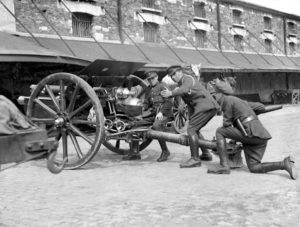
The event that decided the opening phase of the Irish Civil War, was the National Army seaborne landings in the south – first at Fenit in Kerry on August 2 and then at three points near Cork city on August 8.
By this time the National Army, perhaps outnumbered by two to one at the outbreak of the Civil War, had already swollen to 14,000 men, and it would reach nearly 40,000 by the end of 1922. Recruitment would also drastically change its character.
Though pro-Treaty IRA veterans would remain in most of the leadership positions, the rank and file came increasingly from veterans of the British Army and many thousands more young men who were recruited without any prior military experience at all.
Several thousand pro-Treaty troops were landed on the southern coast and though there was some hard fighting, within a week Cork city and most of the important towns in south Munster were in government hands. Many of the Cork and Kerry IRA units had been fighting elsewhere when the landings occurred and although many came back to try to hold off the pro-Treaty landings, they were too late.
Anti-Treaty IRA commander Liam Deasy declined to defend Cork city in the streets, undoubtedly sparing that city the inevitable destruction and civilian casualties that would have resulted, as they had in Dublin and Liam Lynch cancelled orders to destroy the Cork Custom House. Humane such orders may have been, but from a military point of view they were disastrous, handing the Free State back its second city and surrendering the anti-Treaty IRA’s main base and source of income.
The anti-Treaty IRA, as they were retreating burned the military barracks in Cork, whic they had occupied since April 1922 and dispersed in some disorder into the countryside.
At least twenty pro-Treaty soldiers were killed in the approaches to Cork and around Tralee and dozens more wounded; but from a purely military point of view the landings had been remarkably successful. Occupying the anti-Treatyites’ southern heartland and restoring civil government and what the government called ‘ordered conditions’ proved a lot more problematic however.
Anti-Treaty forces had been dispersed but not destroyed. After the fall of Cork, Liam Lynch, who had always envisioned a return to guerrilla warfare, issued General Orders for the formation of Active Service Units in each area, not to exceed 35 men and for the systematic destruction of road and rail infrastructure.
The weeks after the fall of Cork, rather than an end to the war, saw a succession of disasters for the pro-Treaty side.
The Free State on the ropes?
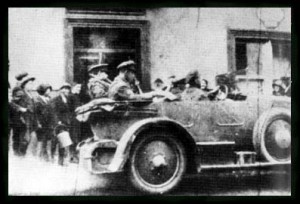
First, Arthur Griffith, the Chairman of the Provisional Government, died of a stroke on August 12. Two days later, Frank Aiken, who had tried to stay neutral but had taken the anti-Treaty side after being arrested by pro-Treaty commander Dan Hogan, re-took Dundalk from the National Army garrison, taking 300 prisoners and large stock of weaponry, prompting fears that he might march south on Dublin.
Eight days later on August 22nd came the greatest shock of all, the death of National Army Commander in Chief Michael Collins in an ambush in West Cork. W.T. Cosgrave took over Griffith’s position as ‘President while Richard Mulcahy succeeded Collins as Army Commander in Chief
The death of Collins and an upsurge in guerrilla attacks around the country in late August and September 1922, made all sides in the conflict think that the Free State was on the ropes.
A British military Intelligence officer in Dublin, for instance reported that, ‘Having crushed the massed resistance of the Republicans, [Free State] troops now find themselves faced with a guerrilla campaign which every day becomes more effective.’ [3]
The National Army had lost relatively few casualties in the ‘line fighting’ of July and early August 1922, but as the conflict morphed into a guerrilla affair, their losses soon spiralled. Collins death was only one of many Free State soldiers, especially in counties Cork, Tipperary and Kerry. Significant concentrations of guerrillas also operated in mountainous areas of Sligo and Mayo as well as urban insurgencies in Dublin and Cork cities and in previously ‘quiet’ areas such as Kildare and south Wexford.
While not all areas were as ‘disturbed’ as these, the National Army actually lost control of several mid-sized towns such as Dundalk, Kenmare and Clifden in this period, as well as failing to establish control over much of the countryside. There were also significant large scale anti-Treaty attacks on the Cork towns of Bantry, Macroom and Ballineen.
In Kerry, pro-Treaty commander WRE Murphy told his commanders that, ‘we are fighting against very superior forces in a very hostile country’ and urgently asked for at least 500 more men.[4]
Similarly in Cork on September 3, 1922, Emmet Dalton, reported that there about 1,000 ‘enemy’ in West Cork and that the situation was ‘very bad’ with ‘a large concentration of irregulars’. He urged the government to send more men and rifles as well as to allow the execution of captured anti-Treatyites. [5]
Executions and reprisals
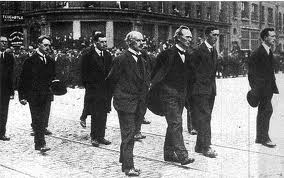
It was in part in response to these setbacks that the Government passed legislation allowing for executions of those captured bearing arms in late September and began carrying them out in mid November, executing in that month eight anti-Treatyites in Dublin, including one time secretary to the Treaty negotiating team Erskine Childers.
This led to the darkest phase of the Civil War as Liam Lynch in reprisal ordered IRA units to kill TDs who had voted for the ‘murder bill’ and to embark on wholesale burning of the houses of Free State supporters.
What followed was a wave of arson attacks across the country, including, famously, on the ‘Big Houses’, particularly of those gentry who had become Free State senators, though hundreds of other ‘small houses’ of Free State supporters were also put to the torch in this period. Lynch’s orders also led to the assassination in Dublin of Cork TD Sean Hales by the IRA. This in turn led to the government’s summary execution of four senior anti-Treaty leaders Liam Mellows, Rory O’Connor, Joe McKelvey and Dick Barret, who had been captured at the Four Courts and who had been held since in Mountjoy Gaol.
This episode and the various other reprisals it spawned lent to the Civil War its particular unforgiving legacy. The hardening of hearts can be shown by Liam Lynch’s response to Eamon de Valera’s plea to call off the house burning campaign after the child of TD Sean McGarry died in one of the blazes. Lynch wrote; ‘The Free State is on the verge of collapse and the burnings are an important part. The IRA wishes to fight with clean hands but the enemy has outraged all the rules of warfare. We must adopt severe measures or chuck it in [i.e. give up] at once.’ [6]
‘Destructive warfare’ and terror
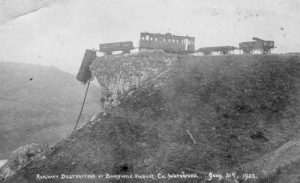
Seán MacMahon, National Army Quartermaster General stated that the ‘Irregulars’ by this time ‘concentrated on explosives, holding up trains, burning houses and destructive warfare, which was very difficult to counteract.’ [7]
According to Liam Lynch the IRA Chief of Staff, the object was no longer to defeat the Free State forces militarily but to hobble their government. He stated; to ‘time is on the side of their Army but against their “Government” ‘what I hope for is to bring the enemy to bankruptcy and make it impossible for a single Government Department to function.’
The core of this strategy was to block the Free State from collecting taxes as well as to smash its government infrastructure, according to Lynch’ orders; anyone paying tax to the Free State was to be fined an equal amount by the IRA, anyone collecting tax for the Free State was to be shot and tax offices and records to be destroyed. ‘Rigid enforcement of this order would almost by itself defeat the enemy army and cause the collapse of his government.’[8]
The National Army maintained that the ‘Irregulars’ support base, particularly in remote rural areas was due to a ‘mercenary motive’ of people who wanted to ‘evade their civic responsibilities’ by not paying taxes, rates or debts.[9]
However the anti-Treatyites also made efforts at collecting levies themselves, particularly a Dog License tax, thousands of forms for which were printed and it was apparently extensively collected in the areas in which their guerrillas were operating, judging by multiple accounts of arrests of republican ‘tax collectors’.[10]
By the end of 1922 Lynch’s strategy was apparently beginning to work. The Cabinet on 20 December 1922 heard: ‘state funds are almost exhausted’ and Minister Patrick Hogan, in January 1923, voiced the opinion that ‘if the Irregulars are able to continue their particular form of warfare … Two more months like the last two months will see the end of us and of the Free State’.[11]
As a result, the Free State intensified its executions in the new year. Minister Kevin O’Higgins, stated that there ‘should be executions in every county. … I believe local executions will considerably shorten the struggle.’… Not only to intimidate the ‘active Irregular’, but also the ‘passive Irregular’ who was not paying taxes, rates or debts. [12] Thirty four men were accordingly shot by firing squad in January 1923, a figure that had reached 81 by May of that year.
The arrest of IRA Divisional commander Liam Deasy, in February, who called on his fighters to surrender, rather than face execution, is an indication that such executions did indeed help to break anti-Treaty morale. Far more common than killing however, for captured anti-Treatyites was imprisonment. Up to 12,000 men and about 300 women were confined to internment camps of prisons by the end of the war.
The republican women’s group Cumman na mBan, who very largely ran the anti-Treaty communications, propaganda, medical and logistical operations, were interned first in September 1922 but released after several hunger strikes. They were re-imprisoned in early 1923 and by March about 250 were interned, first in Kilmainham Gaol and then in North Dublin Union.
A reorganisation of the National Army and essentially flooding the countryside with troops – over 55,000 soldiers were ultimately recruited, technically a breach of the terms of the Treaty, but one which the British were happy to overlook – helped the Free State to overwhelm the republicans by weight of numbers.
It is noticeable that in this period many of the pro-Treaty commanders who had overseen the initial phase of the war were removed, resigned or moved on to new roles. Emmet Dalton resigned his command in Cork and left the army. Eoin O’Duffy became Civic Guard (Garda) commissioner, WRE Murphy, hitherto Army commander in Kerry, similarly became commissioner of the Dublin Metropolitan Police.
Former close associates of Michael Collins were also ousted from important positions by Army Commander in Chief Richard Mulcahy, notably Liam Tobin and Charles Dalton as heads of Military Intelligence and Tom Ennis from the southern command.
Mulcahy replaced them with officers who were either young former IRA men such as Michael Costello who eventually became head of Intelligence as well as many former British Army officers. While this does appear to have improved the efficiency of the Army, it also caused major rifts within the Free State’s officer Corps, ultimately leading to a mutiny of some of those officers 1924 when they were facing demobilisation.
A very bitter ending
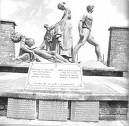
By March 1923 it was clear that even what Patrick Hogan had described as the anti-Treaty side’s ‘particular form of warfare’ was collapsing. The guerrillas had mostly been confined by this time to remote mountainous areas, large groups coalesced particularly around the Cork-Kerry border, parts of Limerick and Tipperary, north Mayo/south Sligo and a group around the Arigna mountains in Leitrim. In urban areas such as Dublin and Cork they lived a fitful, clandestine existence.
Most columns were on the run, many with their leaders arrested. In most areas all they could achieve by the spring of 1923 was blocking roads, demolishing bridges and cutting telephone wires, with the occasional sniping at Free State garrisons.
The exception to this was Kerry, where anti-Treaty military resistance remained tenacious almost to the last. It was in Kerry also where the war’s worst atrocities took place. When five pro-Treaty soldiers were killed by a booby trap bomb at the village of Knocknagoshel on March 6, Paddy O’Daly, General Officer Commanding in Kerry, in revenge conducted a series of massacres of anti-Treaty prisoners.
Within two days, his men had killed eight prisoners at Ballyseedy near Tralee, after tying them around a land mine and detonating it. Four more prisoners were murdered the following day, killed in the same manner, at Countess Bridge near Killarney. Five further anti-Treaty IRA men were blown to pieces some days later at Cahirsiveen. The official army story was that the prisoners had been killed while clearing mines left by their own side.
Such vindictive killings on both sides also occurred on a smaller scale in places such as Dublin, Wexford and Tipperary in March 1923 as the conflicted degenerated into a series of spiteful revenge killings.
While pro-Treaty troops had suffered considerably larger losses in combat than the anti-Treatyites, it was they, not perhaps coincidentally, who carried most ‘summary executions’ in the war, often seeking to ‘even the score’ for what they regarded as cowardly anti-Treaty ambushes or mine attacks.
Republicans later logged at least 113 such killings[13] of their men, either killed after arrest or capture or assassinated, while various counts of Free State soldiers killed while unarmed or prisoners range from 53 to just eleven.[14]
This aspect of the Civil War, which anti-Treatyites such as Liam Lynch commented on extensively at the time, along with the official executions, contributed to a lasting bitterness on behalf of anti-Treaty veterans of the conflict against the Free State and its forces.
Nevertheless by this time it was clear that the Free State was winning the battle to establish a working administration in spite of the anti-Treaty campaign of sabotage. The Civic Guard (later renamed Garda Siochana) began to function, although usually under military escort and rates and taxes to be collected.
In Kerry for example on 10 April 1923, the Army reported that rate collection ‘previously most delinquent’, was ‘progressing for fear of severe fines from the Civic Guard’.[15] By May 1923 National Army Intelligence reported that even in areas where ‘the Irregulars’ had previously had support, public opinion was changing now that ‘it is no longer a paying proposition to support disruptionist forces’. [16]
Liam Lynch maintained to the last that his strategy would ultimately work, insisting that if prolonged long enough it would force both the Free State and the British to come back to the negotiating table and re-negotiate the Treaty. His commanders on the ground however knew that their war effort was collapsing, their fighters either in hiding or surrendering.
In a heated exchange with Lynch, IRA Director of Intelligence Michael Carolan pointed out that the Free State would in fact never go bankrupt as long as there were banks willing to lend to it; ‘credit is the important thing and this is still good enough to enable him [the enemy] to carry on’.[17]
It was only the death of Lynch, shot while fleeing from Free State troops in the Knockmealdown mountains on April 14 1923 that brought the war to a close. Lynch’s successor as IRA Chief of Staff, Frank Aiken, working closely with political leader Eamon de Valera called a ceasefire and shortly afterwards issued a ‘dump arms’ order, for weapons to be hidden and for their fighters to return home.
In fact however, with no amnesty from the government until December 1923, many, including de Valera himself were arrested and interned in the summer of 1923, in his case during a rally for the August 1923 election in Ennis.
The National Army themselves concluded that while they had won a military victory, the imposition of ‘ordered conditions’ would take more time, writing in April 1923; ‘The state of the country … cannot be considered satisfactory, but from a military point of view cannot be considered anything else but good … Armed opposition in anything like column strength can only be found in a few places … and is very weak’.[18]
Violence flickered and flared spasmodically across the country for the rest of the year, including aftershocks of the Civil War itself along with armed robberies and violent land and labour disputes. A part of the Free State’s army was peeled off into a Special Infantry Corps to deal with social disorder.
It was not until mid 1924 that armed crime, the remaining political violence as well as social strife on the land and of striking workers (and their employers) began to die down. It was not until that time either that the last anti-Treaty prisoners were released.
Casualties
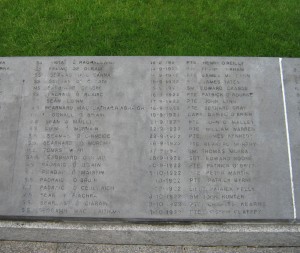
The casualties of the Irish Civil War were not heavy by contemporary European standards, but the total death toll approached 2,000 and was similar to the twenty-six county death toll of 1919-21.
Just under 800 National Army soldiers were killed, of whom 488 died due to enemy action, seven were executed having deserted to the other side, 213 died in firearms or other accidents and another 69 who died of illness or natural causes. [19]
Anti-Treaty Republicans listed 426 of their Volunteers killed [20] (including those who died in Northern Ireland in the first half of 1922), but studies of counties such as Limerick and Cork indicate that this is a considerable underestimate of their losses. It is likely that the anti-Treaty combatant’s death toll was about 500.
There is no definitive list of civilian casualties. However, studies of ten of the most violent counties in the Civil War reveal a total of about 220 civilian deaths. While this is a minority of the twenty six counties in the Free State, it includes the most populous ones and the ones where most military activities occurred. Allowing for a high estimate of an average of ten civilian fatalities in the remaining 16 counties, the civilian death toll was probably between 3 and 400. [21]
This is far fewer than the 898 civilians killed in the 1919-21 War of Independence, during which both sides targeted civilians far more indiscriminately than in the 1922-23 conflict, or in Northern Ireland in 1922 for that matter. The IRA, for example, killed nearly 200 individuals as alleged informers in the War of Independence compared to just 13 in the Civil War of 1922-23.[22]
Long after the dead were buried however, the material destruction repaired and the prisoners released from internment, the Irish Civil War cast a shadow over the politics and governance of the new Irish state.
If you like the Irish Story and wish to support our work, please considering contributing at our Patreon page here.
References
[1] Ernest Blythe BMH WS 939.
[2] Collins memo on General Situation 27/7/22, Mulcahy Papers, UCD P/7/B29.
[3] British Intelligence reports August to September 1922 in De Valera Papers UCD P150/1646.
[4] Military Archives, Kerry Command WRE Murphy to commander in Chief, 1 October 1922 CW/OPS/08/01
[5] Military Archives, CW/OPS/01//02/06, Radio reports to GHQ
[6] De Valera Papers UCD P150/1749.
[7] MacMahon testimony to Army Inquiry, April 1924, Mulcahy Papers UCD P7/C/14.
[8] De Valera-Lynch correspondence 14 December 1922 and 28 December 1922. General Order issued 27/12/1922 Twomey Papers UCD P69/2.
[9] Military Archives, Kerry Intelligence reports, CW/OPS/08/02
[10] As list in Military archives MIPR-02-42, Limerick Cmd rpt from IE/MA-CREC-04
[11] Mulcahy Papers UCD P7/B/245.
Hogan Cited in Hopkinson, Green Against Green, p. 222.
[12] Included in O’Higgins testimony to Army Inquiry 1924, Mulcahy Papers UCD P7/C/21.
[13] Wolfe Tone Annual 1963, p. 245.
[14] James Langton, Forgotten Fallen, p.9
[15] Military Archives, Intelligence reports Kerry command , CW/OPS/08/02
[16] Military archives, Limerick Command reports 1923, 31 May 1923 cw/ops/09/09
[17] DI to CS 28/3/1923 Twomey Papers UCD P69/11.
[18] NA Intelligence reports 1 April 1923, Mulcahy Papers UCD P7/B/138.
[19] Langton, forgotten Fallen, p.9
[20] The Last Post 1985, National Graves Association, New York pp130-154
[21] John Dorney, ‘Casualties of the Irish Civil War in Dublin’; Dorney, ‘Casualties of the Civil War in Tipperary’; idem, ‘Casualties of the Civil War in County Cork’; idem, ‘Casualties of the Civil War in Limerick’; Aaron O Maonaigh, Civil War Casualties in Co Wicklow. Michael Farry, The Aftermath of Revolution: Sligo 1921–23 (Dublin, 2000); Phillip McConway, ‘The Civil War in Offaly’, Offaly Tribune, 2 Jan. 2008; Tom Doyle, The Civil War in Kerry (Cork, 2009), pp 328-331; James Durney, The Civil War in Kildare (Cork, 2011), pp 14-15; Eoin Swithin-Walsh, Kilkenny in Times of Revolution, 1900-1923 (Kildare, 2018), p. 249; Cormac Ó Súilleabháin, Leitrim’s Republican Story, 1900-2000 (Béal an Átha Móir, 2019), p. 418; Ó Maonaigh, ‘Wexford’s Civil War dead: a statistical survey’, pp 89-109; Seán Ó Súilleabháin, Longford’s Republican Story, 1900-2000 (Béal an Átha Móir, 2021), p. 481.
[22] Padraig O Ruairc, Spies and Informers Beware, IRA Executions of Civilians during the War of Independence, https://www.theirishstory.com/2017/06/04/spies-and-informers-beware-ira-executions-of-alleged-civilian-spies-during-the-war-of-independence-1919-1921/#.YriKKXbMLIU also O Ruairc’s talk on killing of informers during the Civil War, conference at UCC Cork, June 18 2022, online here.